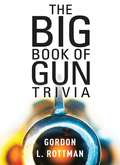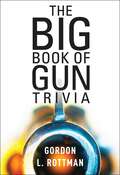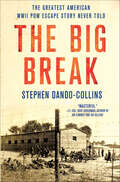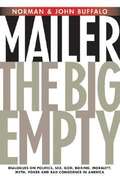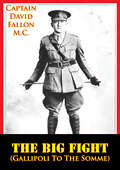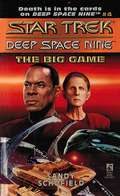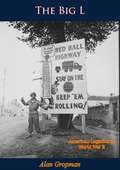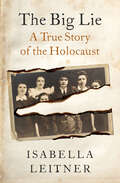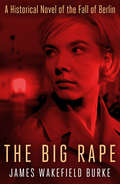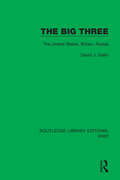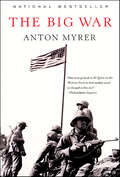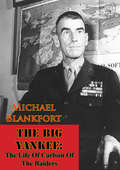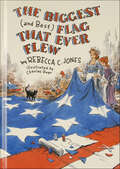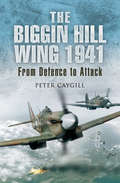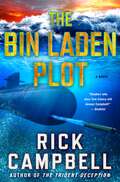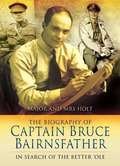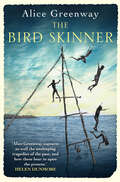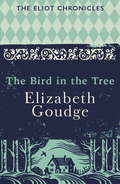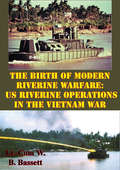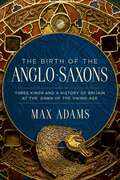- Table View
- List View
The Big Book of Gun Trivia
by Gordon L. RottmanThe Big Book of Gun Trivia: Everything you want to know, don't want to know, and don't know you need to know
The Big Book of Gun Trivia
by Gordon RottmanA complete guide to weapons history, facts, myths and trivia, covering everything you wanted to know, didn't want to know, and don't know you need to know... Gordon Rottman offers a step by step guide through interesting gun facts and statistics, including a section on ammunition, while breaking apart popular myths and misconceptions. Covering subjects from weapons designations to the longest serving military rifles, where rifles get their names from, and everything in between, Osprey is proud to present The Big Book of Gun Trivia.
The Big Breach: From Top Secret to Maximum Security
by Richard TomlinsonRichard Tomlinson was recruited by MI6, the British foreign intelligence service, during his senior year at Cambridge University. He quickly gained the trust and confidence of one of the world's most effective intelligence organisations. MI6 relied on Tomlinson to smuggle nuclear secrets out of Moscow, to run an undercover operation in Sarajevo while the city was under siege, and to infiltrate and dismantle a criminal group that sought to export chemical weapons capabilities to Iran.
The Big Break: The Greatest American WWII POW Escape Story Never Told
by Stephen Dando-CollinsThe story opens in the stinking latrines of the Schubin camp as an American and a Canadian lead the digging of a tunnel which enabled a break involving 36 prisoners of war (POWs). The Germans then converted the camp to Oflag 64, to exclusively hold US Army officers, with more than 1500 Americans ultimately housed there. Plucky Americans attempted a variety of escapes until January, 1945, only to be thwarted every time.Then, with the Red Army advancing closer every day, camp commandant Colonel Fritz Schneider received orders from Berlin to march his prisoners west. Game on! Over the next few days, 250 US Army officers would succeed in escaping east to link up with the Russians - although they would prove almost as dangerous as the Nazis - only to be ordered once they arrived back in the United States not to talk about their adventures. Within months, General Patton would launch a bloody bid to rescue the remaining Schubin Americans.In The Big Break, this previously untold story follows POWs including General Eisenhower's personal aide, General Patton's son-in-law, and Ernest Hemingway's eldest son as they struggled to be free. Military historian and Paul Brickhill biographer Stephen Dando-Collins expertly chronicles this gripping story of Americans determined to be free, brave Poles risking their lives to help them, and dogmatic Nazis determined to stop them.
The Big Empty: Dialogues on Politics, Sex, God, Boxing, Morality, Myth, Poker, and Bad Conscience in America
by Norman Mailer John Buffalo MailerSet against the backdrop of George W. Bush's re-election campaign and the war in Iraq, John asks his father to look back to World War II and explore the parallels that can and cannot be drawn between that time and our current post-9/11 consciousness.
The Big Fight (Gallipoli To The Somme) [Illustrated Edition]
by Captain David Fallon M.C.Includes the First World War Illustrations Pack - 73 battle plans and diagrams and 198 photos"Gallipoli and the Western Front to the end of 1916, as experienced by the author who served with the Australians and 1/Buckingham Bn of the O&B LIThis book is an account of the author's battlefield experiences at Gallipoli and on the Western Front. Fallon was a pre-war regular (Northumberland Fusiliers) who, when war broke out, was a staff sergeant instructor at the Australian Royal Military College in Duntroon. Transferred in some unexplained fashion to the Australian army he took part in the Gallipoli landings on 25 April 1915, which he describes in gory detail, as he does the rest of the fighting till he was evacuated in December. Back in the British army he was commisioned into the Buckingham Battalion (TF) of the O & B LI (145th Bde/48th Division) with which he fought on the Western Front till badly wounded at the end of 1916. He seems to go out of his way to make his descriptions of the fighting as bloody as possible, and as for the Germans, he has a chapter entitled "Hun Beastliness" in which he makes unbelievable statements such as the two examples which follow: It was the nude body of the Mother Superior. She had been nailed to the door. She had been crucified. In the ruins we brought out the bodies of four nuns, unspeakably mutilated. Their bodies had been stabbed and slashed each more than a hundred times. They had gone to martyrdom resisting incredible brutes. They had fought hard, the blond hair of their assassins clutched in their dead hands. And again, at Wytschaete: Above the wreck of the skyline trench bayonets stuck up, and on them were the severed heads, with horrible smiles under their English caps, of twenty of my men. Referring to German soldiers he writes: They hate the bayonet. The cold steel is not for Hans. Shades of Dad's Army, Lcpl Jones and "They don't like it up 'em"."-Print ed.
The Big Game (Star Trek: Deep Space Nine #4)
by Sandy SchofieldWhen Quark holds a poker tournament on Deep Space NineTM someone from almost every sentient race -- Klingons, Cardassians, Romulans, Vulcans, Ferengi -- shows up for what is sure to be the highest-stakes game of all time. But when one player is killed, the stakes get higher than even these big-money players had counted on. With the station rocked by subspace waves that threaten its destruction, Commander Sisko and Security Chief Odo must hunt down the killer in time to save the players, a killer who has information that can save those onboard Deep Space Nine from the invisible enemy they do not even know they face, a killer who holds all the cards...
The Big L: American Logistics in World War II
by Alan GropmanAmerican logistics in World War II was “big” by just about any measure one can devise. There is no question that it played a dominant role in the allied victory and thereby shaped the history of the rest of the century. The lessons of that achievement, consequently, remain essential today, especially for those who study and work with the resources component of United States grand strategy. So it is important that those lessons be accurate, that they portray a balanced view, pointing out shortcomings as well as documenting great successes; otherwise, a mythologized picture of the “Arsenal of Democracy” may be perpetuated. It was in this spirit that the Industrial College of the Armed Forces convened a symposium to address the lessons of World War II logistics—”the Big L.” The extended essays published here began as papers delivered at the symposium, then were expanded and revised for this book. Written by faculty of the Industrial College, they address the massive subject from seven perspectives: industrial mobilization; acquisition of war materials; the economics of mobilization; the building of infrastructure; the Lend-Lease program; joint logistics in the Pacific Theater; and joint logistics—the “materiel battle “—in Europe. The American effort—mind-boggling as it was in sheer numbers—was flawed in many respects. With the advantage of hindsight, the authors take a hard, unsentimental look at these areas of WWII logistics and offer a balanced analysis that will best serve our understanding of this subject.
The Big Lie: A True Story
by Isabella LeitnerThe Pulitzer Prize–nominated author recounts her Holocaust experience—her imprisonment at Auschwitz and her dramatic escape—in this book for young readers. As World War II rages in Europe, the fighting seems far away from Isabella Leitner and her family. Only rumors of Nazi horrors have reached them, and they feel safe in the small Hungarian town of Kisvarda. That is, until March 20, 1944 . . . Overnight, Isabella&’s whole world changes. Suddenly, she must wear a yellow star, be inside by curfew, and cannot go back to school. And that&’s only the beginning. Her family is rounded up by Nazi soldiers. They are put in cattle cars and taken to Auschwitz, a death camp in Poland. Only Isabella and three of her sisters are kept together, the rest of their family is forced to separate parts of the camp. Together, the four girls face their worst fears—until they get a chance at freedom. The Big Lie offers a look at history through the eyes of a woman whose strength and hope helped her overcome the worst of human nature. Leitner&’s &“approach allows readers to appreciate the young Isabella&’s incomprehension of the Final Solution even as she generates a coherent and compelling narrative&” (Publishers Weekly).
The Big Rape
by James Wakefield BurkeThe Big Rape, was first published in 1952 by Esquire's war correspondent James Wakefield Burke (1904-1989). The book, historically accurate in terms of place and events, is a fictional account of a German woman – Lilo Markgraf – in Nazi Germany, and traces the fall of Berlin to the Russians, and the subsequent widespread rape and debauchery the Red Army soldiers inflicted on the populace. At first, Lilo is an ardent nationalist and in love with a German soldier, but following the rape of her mother and her younger sister by Russian soldiers, Lilo returns from a small town to Berlin to attempt her revenge. She later becomes the mistress of a Soviet NKVD officer, taking advantage of the protection and benefits he can provide her. Finally, with the coming of the Americans in their occupied portion of Berlin, she attempts to plan her future.
The Big Ships Are Coming!
by Bill BeckerA novel about the liberation invasion of Guam in 1944, as seen through the eyes of a ten-year-old boy.
The Big Three: The United States, Britain, Russia (Routledge Library Editions: WW2 #2)
by David J. DallinThis book, first published in 1946, analyses the state of the world at the close of the Second World War. Global power was passing from Britain to the United States and the Soviet Union, with the US being involved in every part of the world, Russia dominant in eastern Europe and the world looked a very uncertain place. This survey of the main three powers examines their changing conditions and foreign policies.
The Big War
by Anton Myrer“One must go back to All Quiet on the Western Front to find another novel as charged as this one!” — Philadelphia InquirerNATIONAL BESTSELLERThey were our husbands, our fathers, our lovers, our sons. They were Americans and Marines. And this is their story: The Big War, Anton Myrer's panoramic novel of Marines in the Pacific in World War II. This is the story of Alan Newcombe, the Boston society Harvard man; Danny Kantaylis, the natural-born leader; Jay O'Neill, the barroom scrapper. Myrer does not glorify war; he does not flinch from describing what the actual experience of warfare was like for a desperate group of Marines trapped in some of the worst fighting conditions of the war. We learn about their lives at home and their fates on the battlefield.
The Big Yankee: The Life Of Carlson Of The Raiders (The\elite Unit Ser. #36)
by Michael BlankfortIncludes 12 IllustrationsThis biography is the story of one of the most impressive figures to emerge from World War II. Evans F. Carlson is a living war hero who has won a place in the hearts of thousands of Americans through his courage, his humanity, and his grasp of the issues of war and peace. It is the story of Carlson the soldier and of Carlson the great American who has struggled against prejudice, complacency and ignorance to realize his vision of democracy in our military organizations and in the world at large.Here is the picture of the magnetic military leader who built up the revolutionary Raider Battalion on the principles of "Gung-Ho" and led it into the first land encounter with Jap forces. But underneath the superefficient soldier and planner of battles is the American looking for a way to fulfill the promise of our tradition. Carlson was raised in New England; he ran away from home, entered the Army, was sent to Europe, learned about guerilla warfare in Nicaragua and Asia. His first visit to China opened his eyes to the struggle men were still making to achieve democracy. He lived and fought with the Eighth Route Army. He tried to tell the world what he had learned about military democracy and the threat of Japanese fascism. Officialdom, however, was not ready for his message and he had to resign from the Marine Corps to bring his warning to the American people. Time proved his predictions true, and after 1941 he rejoined the Marines and organized the famous Raider Battalion, which put in practice what he had learned in China and all that he believed about American democracy.Michael Blankfort was in the Marine Corps himself and got to know Colonel (now Brigadier General) Carlson there. He has written this biography through this personal knowledge of Carlson and through conferences with his family and close friends and enthusiastic veterans who served with him.
The Biggest (and Best) Flag That Ever Flew
by Rebecca C. JonesYoung Caroline Pickersgill lives with her mother and grandmother in Baltimore, Maryland. Mrs. Pickersgill, a widow, supports herself and her daughter by making flags for the ships that sail into the city. Some soldiers from Fort McHenry come to her to order the biggest and best flag in the world, and Caroline helps make it. When the British sail up the Chesapeake Bay to destroy Baltimore during the War of 1812, the defenders at the fort beat them back. After the British sail away the next day, the flag “gallantly streaming” over the fort is the one Caroline and her mother had sewn. By “the dawn’s early light,” Francis Scott Key saw it waving “o’er the land of the free and the home of the brave.” Here is a charming (and true) children’s story about a young girl who, in helping her widowed mother, became a part of our nation’s history.
The Biggin Hill Wing, 1941: From Defence to Attack
by Peter CaygillAn in-depth study of England&’s most famous fighter station during the year of the Battle of Britain. The Biggin Hill Wing, 1941 looks at the political upheaval within Fighter Command that saw the removal of Sir Hugh Dowding and Keith Park and their replacement by Sir William Sholto Douglas and Trafford Leigh-Mallory. The ongoing Big Wing controversy and the resulting change in tactics during 1941 are examined. The main part of the book is a chronological account of the squadrons of the Biggin Hill Wing, with particular emphasis on the pilots. The units covered include No.s 66, 72, 74, 92, 124, and 609 Spitfire Squadrons and 264 Defiant Night Fighter Squadron. The author&’s research is based on combat reports and squadron Operation Record Books as well as firsthand accounts written by the participant pilots in the battles over southern England and northern France. Extensive appendices include Air Combat Claims of the Wing, Operational Aircraft Losses, Details of Selected Operations, and The Great Escape, which recounts the marked influence of ex-Biggin Hill pilots on the escape from Stalag Luft III in 1944.
The Billionaire (The O'Banyon Brothers)
by J. R. WardThis billionaire’s got it bad, and that’s not good… The first O’Banyon Brothers novel from New York Times bestselling author J.R. Ward writing as Jessica Bird. Originally published in 2007 as The Billionaire Next Door.Take-no-prisoners deal-maker Sean O’Banyon (aka SOB) eats Wall Street financiers for lunch. So why is he losing sleep over a sweet-faced nurse in old jeans and a too-big T-shirt? Maybe it’s those warm green eyes. Or the way she blushes when he gets personal. Maybe it’s the way she challenges everything he’s believed about himself for so long.There’s no denying they have serious chemistry. But sooner or later Lizzie will learn his deep, dark secrets. First, he has trust issues. Second, the whole family thing is not for him. And, last, he doesn’t do relationships—even if there’s something about Lizzie that makes him want everything he can’t have…
The Bin Laden Plot: A Novel (Trident Deception Series #7)
by Rick CampbellA U.S. destroyer is torpedoed by an Iranian submarine and Captain Murray Wilson of the U.S.S. Michigan is flown to the Pentagon to meet with the Secretary of the Navy (SecNav). There Wilson learns that the Iranian submarine is just a cover story. One of the United States' own fully automated unmanned underwater vehicles has gone rogue, its programming corrupted in some way. Murray is charged with hunting it down and taking it out before the virus that's infected its operating system can infect the rest of the fleet. At the same time, the head of the SEAL detachment aboard the U.S.S Michigan is killed and Lonnie Mixell, a former U.S. operative, now assassin for hire, is responsible. And that is only the first SEAL to be hunted down and killed. Jake Harrison, fellow SEAL, discovers that these SEALs had one mission in common - they were all on the team that killed Bin Laden. Or so the world was told. As Wilson discovers that his mission is actually meant to cover up dangerous acts of corruption, even treason, Harrison discovers that the assassin is out to protect the same forces. Forces too powerful for either of them to take on alone.
The Biography of Captain Bruce Bairnsfather: In Search of the Better 'Ole
by Tonie Holt Valmai HoltBruce Bairnsfather created one of the best-known cartoon characters of the First World War - 'Old Bill' and he drew what many consider to be the most enduring cartoon of all time - the 'Better Ole'.Reprinted due to popular demand this biography was the first to be published about the man and his work. During the First World War the contribution of Bairnsfather's work to the morale of the Nation, through laughter, is without question. Indeed these were those who thought he was the 'man who won the war'. The authors trace his life in fascinating detail. This delightful book reveals details of the man who was a compelling paradox - a desperately shy person who adored the limelight, a loyal loveable personality, ridden with suspicion, an upper class product who was more comfortable in the company of the working class man.Bairnsfather's work appears on plates, cups, jugs, mugs and pots, carmascots, ashtrays and the like - all collector's pieces. His characters appear on postcards, playing cards, cigarette card, jig-saw puzzles and during the Second World War on the noses of the daylight bombers of the American Eighth Airforce.The story is lavishly illustrated with over 150 photographs and drawings, and includes a useful section setting out the range and values of Bairnsfather memorabilia and collectables.
The Bird Skinner
by Alice GreenwayFrom the award-winning author of White Ghost Girls comes an evocative tale of memory, loss—and the redemptive power of friendship. It is 1973. Jim Kennoway, a distinguished ornithologist and World War II veteran, has just left his work at the Natural History Museum in New York, turned his back on his family, and retreated to an island boathouse off the coast of Maine. His desires are simple: to be left alone with his cigarettes, gin, and battered copy of Treasure Island, and to forget. Jim's solitude is shattered when Cadillac Baketi, a tall, ebullient, and dazzlingly bright young woman from the Solomon Islands arrives on her way to study medicine at Yale University. Cadillac is the daughter of Tosca, an island scout Jim befriended during the war when they collected and skinned birds while spying on the Japanese. Jim curses the intrusion as he finds his thoughts catapulting back to his youth and a dark truth about his time in the Solomons. Yet it may be that Cadillac, from the Pacific islands Jim thought he'd left behind, can teach him to be human again.
The Bird in the Tree: Book One of The Eliot Chronicles
by Elizabeth GoudgeEssential reading for fans of E.M. Forster, Mary Stewart and Elizabeth Jane Howard.The first in the classic family saga about the Eliots of Damerosehay. Lucilla Eliot has spent a lifetime making the Hampshire estate of Damerosehay a tranquil haven for her family.When her beloved grandson, David, falls in love with an unsuitable woman, Lucilla sees her most cherished ambitions put at risk. But can she persuade David and Nadine to put duty and family honour before love?What readers are saying about THE ELIOT CHRONICLES'Goudge has produced a truly enchanting world with Damerosehay at its heart. Perfect' - 5 STARS'A delightful 'feel-good' family saga' - 5 STARS'A beautifully-written trilogy' - 5 STARS'Joyful, affirming and uplifting' - 5 STARS'A complete antidote to murder and mayhem!' - 5 STARS
The Birth Of Modern Riverine Warfare: US Riverine Operations In The Vietnam War
by Lieutenant Commander William B. BassettThis paper examines U.S. riverine operations in the Vietnam War. With the current drive to establish a riverine capability within the U.S. Armed Forces as an integral part of the GWOT and small wars of the future, the evolution and operation of the U.S. riverine force during the Vietnam War serves as an effective blueprint for the conduct of modern riverine warfare.American riverine forces in Vietnam operated in a diverse range of brown and green water environments, successfully conducting a wide variety of missions. The evolution of these forces reflected the continuing need to develop the capabilities necessary for these operations. Their success was largely derived from experience which resulted in the creation of a variety of discrete riverine task forces specially configured for their specific missions as the situation dictated. U.S. riverine operations in Vietnam illustrate the complex nature of operations in brown and green water and the inherently joint requirement of the forces involved. The lessons learned as a result of these operations should be incorporated as a fundamental part of the creation of any modern riverine force.
The Birth of Britain (A History of the English-Speaking Peoples, Volume I)
by Winston ChurchillCovers English history to the end of the reign of Richard III. Three additional volumes deal with modern England, its colonies, and modern times. `
The Birth of the Anglo-Saxons: Three Kings and a History of Britain at the Dawn of the Viking Age
by Max AdamsA brilliant, authoritative narrative of the golden age of the Anglo-Saxon kingdom in Britain by an acclaimed historian of this period.The eighth century has for too long been a neglected era in British history: a shadow land between the death of Saint Bede and the triumphs of King Ælfred and the eventual unification of England. But before the victories of King Ælfred against the Viking invaders, the kingdom of Mercia—spread across a broad swathe of central England—was the reigning power that exercised central political authority for the first time since the Roman Empire. This authority was used to construct trading networks and markets; to develop strong economic, cultural, and political links with the Continent; and to lay the foundations for a system of defense that would be invigorated and reinvented by Ælfred at the end of the ninth century. Two kings, Æthelbald (716–757) and Offa (757–796), dominated the political landscape of the rising power of Mercia. During their reigns, monasteries became powerhouses of royal patronage, economic enterprise, and trade. Offa constructed his grandiose dyke along the borders of the warlike Welsh Kingdoms and, more subtly, spread his message of political superiority through coinage bearing his image. But Æthelbald and Offa between them built something with an even more substantial legacy—a geography of medieval England. And these two kings engineered a set of tensions between kingship, landholding, and the church that were to play out dramatically at the dawn of the Viking Age. In this illuminating history of Early Medieval Britain, Max Adams reconnects the worlds of the three kings—Æthelbald, Offa, and Ælfred—in an absorbing study of the landscape, society, and politics of a fascinating century of change.
The Birth of the Palestinian Refugee Problem Revisited
by Benny MorrisBenny Morris' The Birth of the Palestinian Refugee Problem was published in 1988. Its startling revelations about how and why 700,000 Palestinians left their homes and became refugees during the Arab-Israeli war in 1948 undermined traditional interpretations as to whether they left voluntarily or were expelled as part of a systematic plan. This 2004 book represents a revised edition of the earlier work, compiled on the basis of newly-opened Israeli military archives. While the focus remains the 1948 war and the analysis of the Palestinian exodus, the new material contains more information about what happened in Jerusalem, Jaffa and Haifa, and how events there led to the collapse of Palestinian urban society. It also sheds light on the battles and atrocities that resulted in the disintegration of rural communities. The story is a harrowing one. The refugees now number four million and their existence remains a major obstacle to peace.
